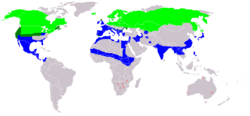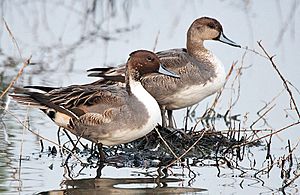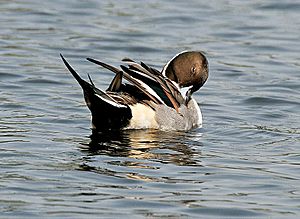Northern Pintail facts for kids
Quick facts for kids Northern Pintail |
|
|---|---|
 |
|
| Conservation status | |
| Scientific classification | |
| Kingdom: | |
| Phylum: | |
| Class: | |
| Order: | |
| Family: | |
| Genus: |
Anas
|
| Species: |
A. acuta
|
| Binomial name | |
| Anas acuta Linnaeus, 1758
|
|
 |
|
| Light Green - nesting area Blue - wintering area Dark Green - resident all year Red X - Vagrant |
|
| Synonyms | |
|
Dafila acuta |
|
The northern pintail (Anas acuta) is a beautiful duck found all over the world. These ducks breed in the northern parts of Europe, Asia, and North America.
They are migratory birds. This means they fly south for the winter. They can travel as far as the equator to find warmer places. Even though they live in many places, there are no different types (subspecies) of northern pintails.
Northern pintails are large ducks. The male has long tail feathers, which is how they got their name. Both male and female ducks have blue-grey bills and grey legs. The male duck is more colorful. He has a chocolate-brown head and a white stripe down his neck. His belly is mostly white. His back and sides have cool grey, brown, and black patterns.
The female duck is less colorful. She has soft brown feathers, much like other female dabbling ducks. Female pintails make a loud "quack" sound. Male pintails make a soft, flute-like whistle.
Northern pintails live in open wetlands, like marshes and swamps. They build their nests on the ground, often away from the water. They find food by "dabbling." This means they dip their heads into the water to eat plants. During nesting season, they also eat small invertebrates. When they are not breeding, they like to be in large groups. They often join other types of ducks.
Their numbers can be affected by predators, tiny parasites, and bird diseases. Human activities like farming and hunting also impact them. But because there are so many of them and they live in such a large area, they are not currently in danger globally.
Contents
What Does a Northern Pintail Look Like?
The northern pintail is a fairly large duck. Its wings are about 23.6–28.2 cm (9.3–11.1 in) long. Their wingspan can be 80–95 cm (31–37 in) wide.
Male pintails are bigger than females. Males are about 59–76 cm (23–30 in) long and weigh 450–1,360 g (0.99–3.00 lb). Females are about 51–64 cm (20–25 in) long and weigh 454–1,135 g (1.001–2.502 lb).
The male duck in breeding season is easy to spot. He has a chocolate-brown head and a white chest. A white stripe goes up the side of his neck. His back and sides are grey. He has long grey feathers with black stripes on his back. His belly near the tail is yellow, and the underside of his tail is black. His long tail feathers can be up to 10 cm (3.9 in) long! His bill is bluish, and his legs are blue-grey.
The adult female is mostly light brown with wavy patterns. Her head is more plain grey-brown. Her tail is pointed but shorter than the male's. You can still tell she's a pintail by her shape, long neck, and long grey bill. When males are not breeding, they look similar to females. But they keep their male wing patterns and long grey shoulder feathers. Young pintails look like females, but their patterns are not as neat.
Pintails can walk well on land and swim well in water. They fly very fast. Their wings are slightly swept back when they fly. When a male flies, you can see a black patch on his wing with white edges. The female's wing patch is dark brown with wide white edges.
The male's call is a soft "proop-proop" whistle. The female makes a quacking sound that goes down in pitch. She also makes a low croak when she is startled.
Where Do Northern Pintails Live?
These ducks breed in the northern parts of Eurasia, reaching as far south as Poland and Mongolia. They also breed in Canada, Alaska, and the Midwestern United States.
In winter, they fly south from their breeding areas. They can reach places near the equator, like Panama and parts of Africa and South Asia. Some even fly to Pacific islands, including Hawaii. In Hawaii, hundreds of them spend the winter in shallow wetlands and flooded farms.
Sometimes, pintails make long journeys across oceans. One bird tagged in Labrador, Canada, was found in England just nine days later! Birds tagged in Japan have been found in six different US states. In some areas, like Great Britain and the northwestern United States, pintails live all year round.
Northern pintails like to breed in open, treeless wetlands. This includes wet grasslands, lake edges, or cold tundra. In winter, they use more types of open areas. They can be found in sheltered bays, salty marshes, and coastal lagoons. Outside of breeding season, they gather in very large groups with other ducks.
Northern Pintail Life Cycle
Breeding and Nests
Northern pintails breed between April and June. The female builds her nest on the ground. She hides it among plants in a dry spot. Often, the nest is a bit far from water. It's a shallow dip in the ground. She lines it with plant material and soft down feathers.
The female lays seven to nine cream-colored eggs. She lays one egg each day. Each egg is about 55 mm × 38 mm (2.2 in × 1.5 in) and weighs 45 g (1.6 oz). If predators destroy the first set of eggs, the female can lay another set as late as July.
The female duck sits on the eggs by herself. She incubates them for 22 to 24 days until they hatch. The baby chicks are covered in downy feathers and can move soon after hatching. The mother leads them to the nearest water. There, they eat dead insects floating on the surface.
The chicks learn to fly in 46 to 47 days. They stay with their mother until she finishes shedding her old feathers. About three-quarters of the chicks survive long enough to fly. But less than half of those live long enough to have their own babies. The oldest northern pintail ever recorded lived for 27 years and 5 months!
How Northern Pintails Find Food
Pintails mostly eat plants. They find food by dabbling or "up-ending" in shallow water. This means they tip their bodies upside down with their tails in the air. They usually feed in the evening or at night. They spend much of the day resting.
Their long necks help them reach food. They can get items from the bottom of water up to 30 cm (12 in) deep. This is deeper than other dabbling ducks can reach.
In winter, they mainly eat plant material. This includes seeds and roots of water plants. Sometimes, they eat roots, grains, and other seeds from fields. During nesting season, they mostly eat small animals without backbones. These include water insects, snails, and crabs.
Health and Safety
Young pintails and their nests can be attacked by predators. Mammals like foxes and badgers might try to eat them. Birds like gulls, crows, and magpies also pose a threat. Adult ducks can fly away from predators on land. But nesting females might be surprised by large animals like bobcats. Large birds of prey, such as northern goshawks, can catch ducks from the ground. Fast falcons, like the gyrfalcon, can even catch flying birds.
The northern pintail is a popular bird for hunting. People like to hunt them because they are fast and agile. They are also considered good to eat. Even though there are many pintails, hunting combined with other factors has caused their numbers to drop in some places. Because of this, hunting rules have been put in place to help protect them.
Using lead shot for hunting and lead sinkers for fishing has caused problems. Waterfowl often eat from the bottom of lakes where lead can collect. This can lead to lead poisoning. Now, in many countries, all shot used for waterfowl must be non-toxic. This means it cannot contain any lead.
Images for kids
-
Male in California, U.S.
See also
 In Spanish: Ánade rabudo para niños
In Spanish: Ánade rabudo para niños















